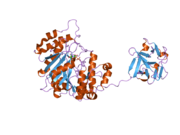Biology:GALNT2
From HandWiki
Revision as of 09:58, 24 October 2021 by imported>Scavis (over-write)
 Generic protein structure example |
Polypeptide N-acetylgalactosaminyltransferase 2 is an enzyme that in humans is encoded by the GALNT2 gene.[1][2][3]
This gene encodes polypeptide N-acetylgalactosaminyltransferase 2, a member of the GalNAc-transferases family. This family transfers an N-acetyl galactosamine to the hydroxyl group of a serine or threonine residue in the first step of O-linked oligosaccharide biosynthesis. The localization site of this particular enzyme is preponderantly the trans-Golgi.[4] Individual GalNAc-transferases have distinct activities, and initiation of O-glycosylation in a cell is regulated by a repertoire of GalNAc-transferases.[3]
References
- ↑ "Genomic organization and chromosomal localization of three members of the UDP-N-acetylgalactosamine: polypeptide N-acetylgalactosaminyltransferase family". Glycobiology 8 (6): 547–55. Jul 1998. doi:10.1093/glycob/8.6.547. PMID 9592121.
- ↑ "Purification and cDNA cloning of a human UDP-N-acetyl-alpha-D-galactosamine:polypeptide N-acetylgalactosaminyltransferase". J Biol Chem 270 (41): 24156–65. Dec 1995. doi:10.1074/jbc.270.41.24156. PMID 7592619.
- ↑ 3.0 3.1 "Entrez Gene: GALNT2 UDP-N-acetyl-alpha-D-galactosamine:polypeptide N-acetylgalactosaminyltransferase 2 (GalNAc-T2)". https://www.ncbi.nlm.nih.gov/sites/entrez?Db=gene&Cmd=ShowDetailView&TermToSearch=2590.
- ↑ "African Swine Fever Virus Causes Microtubule-Dependent Dispersal of trans-Golgi Network". http://jvi.asm.org/cgi/reprint/80/22/11385.pdf.
Further reading
- "cDNA cloning and expression of a novel human UDP-N-acetyl-alpha-D-galactosamine. Polypeptide N-acetylgalactosaminyltransferase, GalNAc-t3.". J. Biol. Chem. 271 (29): 17006–12. 1996. doi:10.1074/jbc.271.29.17006. PMID 8663203.
- "Substrate specificities of three members of the human UDP-N-acetyl-alpha-D-galactosamine:Polypeptide N-acetylgalactosaminyltransferase family, GalNAc-T1, -T2, and -T3.". J. Biol. Chem. 272 (38): 23503–14. 1997. doi:10.1074/jbc.272.38.23503. PMID 9295285.
- "Localization of O-glycosylation sites on glycopeptide fragments from lactation-associated MUC1. All putative sites within the tandem repeat are glycosylation targets in vivo.". J. Biol. Chem. 272 (40): 24780–93. 1997. doi:10.1074/jbc.272.40.24780. PMID 9312074.
- "Localization of three human polypeptide GalNAc-transferases in HeLa cells suggests initiation of O-linked glycosylation throughout the Golgi apparatus.". J. Cell Sci. 111 (1): 45–60. 1998. PMID 9394011.
- "The glycosylation and structure of human serum IgA1, Fab, and Fc regions and the role of N-glycosylation on Fc alpha receptor interactions.". J. Biol. Chem. 273 (4): 2260–72. 1998. doi:10.1074/jbc.273.4.2260. PMID 9442070.
- "Initiation of O-glycan synthesis in IgA1 hinge region is determined by a single enzyme, UDP-N-acetyl-alpha-D-galactosamine:polypeptide N-acetylgalactosaminyltransferase 2.". J. Biol. Chem. 278 (8): 5613–21. 2003. doi:10.1074/jbc.M211097200. PMID 12438318.
- "Generation and initial analysis of more than 15,000 full-length human and mouse cDNA sequences". Proc. Natl. Acad. Sci. U.S.A. 99 (26): 16899–903. 2003. doi:10.1073/pnas.242603899. PMID 12477932.
- "Polypeptide GalNAc-transferases, ST6GalNAc-transferase I, and ST3Gal-transferase I expression in gastric carcinoma cell lines". J. Histochem. Cytochem. 51 (6): 761–71. 2003. doi:10.1177/002215540305100607. PMID 12754287.
- "Conformational studies on the MUC1 tandem repeat glycopeptides: implication for the enzymatic O-glycosylation of the mucin protein core". Glycobiology 13 (12): 929–39. 2004. doi:10.1093/glycob/cwg109. PMID 12925576.
- "Complete sequencing and characterization of 21,243 full-length human cDNAs". Nat. Genet. 36 (1): 40–5. 2004. doi:10.1038/ng1285. PMID 14702039.
- "The Status, Quality, and Expansion of the NIH Full-Length cDNA Project: The Mammalian Gene Collection (MGC)". Genome Res. 14 (10B): 2121–7. 2004. doi:10.1101/gr.2596504. PMID 15489334.
- "The DNA sequence and biological annotation of human chromosome 1". Nature 441 (7091): 315–21. 2006. doi:10.1038/nature04727. PMID 16710414. Bibcode: 2006Natur.441..315G.



